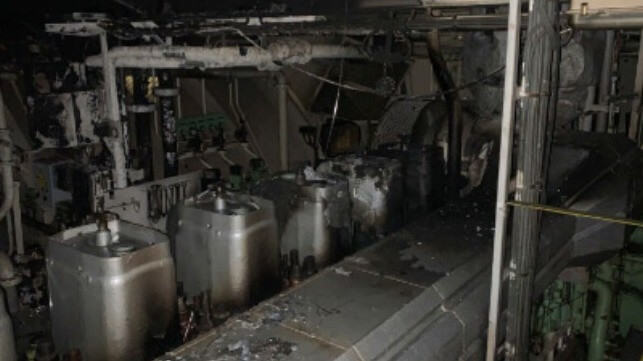NTSB: Failure to Follow Maintenance Procedures Caused $1.2M in Fire Damage

A failure to follow recommended maintenance procedures, or possibly a perceived shortcut in the process, is believed to have caused a fire that resulted in $1.2 million in damage and disabled a 46,700 dwt product tanker while she was maneuvering within the confines of a shipping channel. The National Transportation Safety Board issued a report highlighting how a maintenance error was likely the cause of a preventable casualty, but that the fast response and appropriate actions of the crew prevented more damage or injuries.
The NTSB used this instance to highlight the consequences of a crew’s actions. They report that they have investigated several recent casualties involving mechanical or fuel line fitting failures that led to engine fires following the maintenance of shipboard diesel engines. The report concludes that the fire that occurred in April 2022 aboard the Malta-flagged Endo Breeze “shows what can happen when equipment manufacturers’ recommended maintenance procedures are not followed.”
The 600-foot product tanker was departing the Sunoco Terminal in Linden, New Jersey on April 29, 2022. Approximately two hours after leaving the berth and navigating around Staten Island, the bridge ordered full ahead on the engines. At around the same time, the second and fourth engineers who were making a round in the engine room smelled fuel oil and saw a haze in the air near the starboard main diesel engine. The spotted fuel oil on the deck and a fuel mist coming from the aft end of the engine.
Within approximately two minutes, they noted that the leak had turned into a fire near cylinder no. 4 on the starboard engine and the fire was quickly spreading. The engine room space and control room were evacuated while the second engineer secured all ventilation, pumps, fuel and oil values, and some auxiliary machinery. The vessel lost main power going on to its emergency generator and the engine room’s fixed carbon dioxide fire extinguisher system was employed. The tanker made an emergency anchorage in the Raritan Bay Channel. It would be two days before the New York Fire Department would give the all-clear that the crew could re-enter the engine room with the danger of a reflash.
During its investigation, the NTSB discovered that the second engineer, aided by a motorman and wiper, performed maintenance the previous day on the starboard main engine which included replacing fuel injectors and fuel injector pumps. The second engineer told the NTSB he had experience conducting this type of maintenance and followed the recommended procedures including for the reassembly. He replaced consumable items and reused prescribed parts including the banjo tube and bolts that were found to be in good condition. He also reported testing the engine at the end of the process and found no leaks. In conducting a post-casualty examination, however, the NTSB found a slight offset, resulting in misalignment to the fuel injector pump and a fracture near the top portion of the inboard side of the banjo tube mounting surface to the sealing flange.
Ruling out other issues with the parts, the NTSB writes it is likely the engineer did not correctly follow the manufacturer’s reassembly procedure for the fuel injector pump. It specified an order of steps and points such as the torque settings. The report concludes that when the engine was fully loaded with a full-ahead order, the expanded stress due to heath and the slight misalignment caused the banjo tube to fracture resulting in the leak that caused the fire.
“In this case, not following the tightening sequence described in the diesel engine manufacturer’s manual led to the misalignment and failure of a high-pressure fuel connection on an engine’s fuel injector pump’s assembly,” the report concludes. “Due to the high risk of fire associated with pressurized fuel, when working with diesel engine components, it’s critical to carefully follow manufacturer assembly procedures and review manufacturer manuals and guidance on a regular basis to ensure familiarity with correct maintenance procedures.”
The NTSB report also emphasized the need for training to prevent and contain engine room fires. The crew’s effective response to the fire aboard the Endo Breeze they concluded limited the damage and prevented injuries.
